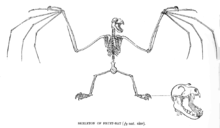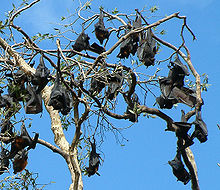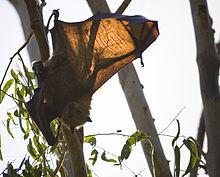- Pteropus
-
"Flying fox" redirects here. For other uses, see Flying fox (disambiguation).
Flying Fox A Malayan Flying Fox (Pteropus vampyrus) Scientific classification Kingdom: Animalia Phylum: Chordata Class: Mammalia Order: Chiroptera Suborder: Megachiroptera Family: Pteropodidae Genus: Pteropus
Erxleben, 1777Species See Text
Bats of the genus Pteropus, belonging to the megabat or Megachiroptera sub-order, are the largest bats in the world. They are commonly known as the fruit bats or flying foxes among other colloquial names. They live in the tropics and subtropics of Asia (including the Indian subcontinent), Australia, Indonesia, islands off East Africa (but not mainland Africa), and a number of remote oceanic islands in both the Indian and Pacific Oceans.[citation needed] There are at least 60 extant species in this genus.
The oldest ancestors of the genus Pteropus to be unearthed appear in the fossil record almost exactly as they are today, the only notable differences being early flight adaptations such as a tail for stabilizing. The oldest megachiropteran is dated at around 35 million years ago, but the preceding gap in the fossil record makes their true lineage unknown.
Characteristically, all species of flying foxes only feed on nectar, blossom, pollen, and fruit, which explains their limited tropical distribution. They do not possess echolocation, a feature which helps the other sub-order of bats, the Microbats, locate and catch prey such as insects in mid-air. Instead, smell and eyesight are very well-developed in flying foxes. Feeding ranges can reach up to 40 miles. When it locates food, the flying fox "crashes" into foliage and grabs for it. It may also attempt to catch hold of a branch with its hind feet, then swing upside down – once attached and hanging, the fox draws food to its mouth with one of its hind feet or with the clawed thumbs at the top of its wings.
Contents
Status
Many species are threatened today with extinction, and in particular in the Pacific a number of species have died out as a result of over-harvesting for human consumption. In the Marianas flying fox meat is considered a delicacy, which led to a large commercial trade. In 1989 all species of Pteropus were placed on Appendix II of Convention on International Trade in Endangered Species of Wild Fauna and Flora (CITES) and at least seven on Appendix I, which restricts international trade. The subspecies P. hypomelanus maris of the Maldives is considered endangered due to limited distribution and excessive culling. The commerce in fruit bats continues either illegally or because of inadequate restrictions. Local farmers may also attack the bats because they feed in their plantations, and in some cultures it is believed their meat can cure asthma. Non-human predators include birds of prey, snakes, and other mammals.
 Drawing of skeleton of an Indian Flying-fox Pteropus giganteus
Drawing of skeleton of an Indian Flying-fox Pteropus giganteus
The Spectacled Flying Fox, native to Australia, is threatened by the paralysis tick which carries paralyzing toxins.[1]
Physical characteristics
On average, P. vampyrus is the largest species, with a wingspan of up to 6 feet (1.83 meters) but a weight of only 1.5 kg (3.3 lb.). Other species have impressive widths, such as the Indian flying fox (P. giganteus) which has a 5 foot (1.5 meter) wingspan. Pelage is long and silky with a dense underfur. No tail is present. As the name suggests, the head resembles that of a small fox because of the small ears and large eyes. Females have one pair of mammae located in the chest region. Ears are simple (long and pointed) with the outer margin forming an unbroken ring (a defining characteristic of megabats). Toes have sharp curved claws.
The primate theory
Some scientists have proposed that flying foxes are descended from primates rather than bats and that mammalian flight ability has evolved more than once. This theory is not accepted by most modern zoologists. For more details see: Flying primates theory.
Species
 Black Flying-fox Pteropus alecto
Black Flying-fox Pteropus alecto
 Livingstone's Fruit Bat Pteropus livingstonii
Livingstone's Fruit Bat Pteropus livingstonii
 Mariana Fruit Bat Pteropus mariannus
Mariana Fruit Bat Pteropus mariannus
 Large Flying Fox Pteropus vampyrus
Large Flying Fox Pteropus vampyrus
Genus Pteropus – flying foxes
- P. alecto species group
- Black Flying Fox, Pteropus alecto
- Torresian Flying Fox, Pteropus alecto, initially was described as separate species Pteropus banakrisi
- Black Flying Fox, Pteropus alecto
- P. caniceps species group
- Ashy-headed Flying Fox, Pteropus caniceps
- P. chrysoproctus species group
- Silvery Flying Fox, Pteropus argentatus
- Moluccan Flying Fox, Pteropus chrysoproctus
- Makira Flying Fox, Pteropus cognatus
- Banks Flying Fox, Pteropus fundatus
- Solomons Flying Fox, Pteropus rayneri
- Rennell Flying Fox, Pteropus rennelli
- P. conspicillatus species group
- Spectacled Flying Fox, Pteropus conspicillatus (extensive entry).
- Ceram Fruit Bat, Pteropus ocularis
- P. livingstonii species group
- Aru Flying Fox, Pteropus aruensis
- Kei Flying Fox, Pteropus keyensis
- Livingstone's Fruit Bat, Pteropus livingstonii
- Black-bearded Flying Fox, Pteropus melanopogon
- P. mariannus species group
- Okinawa Flying Fox, Pteropus loochoensis
- Mariana Fruit Bat, Pteropus mariannus
- Pelew Flying Fox, Pteropus pelewensis
- Kosrae Flying Fox, Pteropus ualanus
- Yap Flying Fox, Pteropus yapensis
- P. melanotus species group
- Black-eared Flying Fox, Pteropus melanotus
- P. molossinus species group
- Lombok Flying Fox, Pteropus lombocensis
- Caroline Flying Fox, Pteropus molossinus
- Rodrigues Flying Fox, Pteropus rodricensis
- P. neohibernicus species group
- Bismarck Flying Fox, Pteropus neohibernicus
- P. niger species group
- Aldabra Flying Fox, Pteropus aldabrensis
- Mauritian Flying Fox, Pteropus niger
- Madagascan Flying Fox, Pteropus rufus
- Seychelles Fruit Bat, Pteropus seychellensis
- Pemba Flying Fox, Pteropus voeltzkowi
- P. personatus species group
- Bismark Masked Flying Fox, Pteropus capistratus
- Masked Flying Fox, Pteropus personatus
- Temminck's Flying Fox, Pteropus temminckii
- P. poliocephalus species group
- Big-eared Flying Fox, Pteropus macrotis
- Geelvink Bay Flying Fox, Pteropus pohlei
- Grey-headed Flying Fox, Pteropus poliocephalus (extensive entry.)
- P. pselaphon species group
- Chuuk Flying Fox, Pteropus insularis
- Temotu Flying Fox, Pteropus nitendiensis
- Large Palau Flying Fox, Pteropus pilosus (19th century †)
- Bonin Flying Fox, Pteropus pselaphon
- Guam Flying Fox, Pteropus tokudae (1970s †)
- Insular Flying Fox, Pteropus tonganus
- Vanikoro Flying Fox, Pteropus tuberculatus
- New Caledonia Flying Fox, Pteropus vetulus
- P. samoensis species group
- Vanuatu Flying Fox, Pteropus anetianus
- Samoa Flying Fox, Pteropus samoensis
- P. scapulatus species group
- Gilliard's Flying Fox, Pteropus gilliardorum
- Lesser Flying Fox, Pteropus mahaganus
- Little Red Flying Fox, Pteropus scapulatus
- Dwarf Flying Fox, Pteropus woodfordi
- P. subniger species group
- Admiralty Flying Fox, Pteropus admiralitatum
- Dusky Flying Fox, Pteropus brunneus (19th century †)
- Ryukyu Flying Fox, Pteropus dasymallus
- Nicobar Flying Fox, Pteropus faunulus
- Gray Flying Fox, Pteropus griseus
- Ontong Java Flying Fox, Pteropus howensis
- Small Flying Fox, Pteropus hypomelanus
- Ornate Flying Fox, Pteropus ornatus
- Little Golden-mantled Flying Fox, Pteropus pumilus
- Philippine Gray Flying Fox, Pteropus speciosus
- Small Mauritian Flying Fox, Pteropus subniger (19th century †)
- P. vampyrus species group
- Indian Flying Fox, Pteropus giganteus
- Andersen's Flying Fox, Pteropus intermedius
- Lyle's Flying Fox, Pteropus lylei
- Large Flying Fox, Pteropus vampyrus
- incertae sedis
- Small Samoan Flying Fox, Pteropus allenorum (19th century †)
- Large Samoan Flying Fox, Pteropus coxi (19th century †)
Footnotes
References
- Altringham, J.D. (1996). Bats: biology and behaviour. Oxford: Oxford University Press. ISBN 0198503229.
- Hall, L. S. & Richards, G. C. (2000). Flying foxes: fruit and blossom bats of Australia. Sydney: University of New South Wales Press. ISBN 0868405612.
- Marshall, A.G. (1985). "Old world phytophagus bats (Megachiroptera) and their food plants: a survey". Zoological Journal of the Linnean Society 83 (4): 351–369. doi:10.1111/j.1096-3642.1985.tb01181.x.
- Mickleburgh, S., Hutson, A.M. & Racey, P. (1992) Old World Fruit Bats: An Action Plan for Their Conservation. Gland, Switzerland: IUCN
- Musser, Guy G.; Karl F. Koopman, and Debra Califia. (1982) The Sulawesian Pteropus arquatus and P. argentatus Are Acerodon celebensis; The Philippine P. leucotis Is an Acerodon. Journal of Mammalogy 63(2):319-328.
- Neuweiler, G. (2000). The Biology of Bats. New York: Oxford University Press. ISBN 0195099516.
- Nowak, R.M. & Walker, E.P. (1994). Walker's bats of the world. Baltimore: Johns Hopkins University Press. ISBN 0801849861.
- Welbergen, J.; Klose, S.; Markus, N.; Eby, P. (2008). "Climate change and the effects of temperature extremes on Australian flying-foxes". Proceedings. Biological sciences / the Royal Society 275 (1633): 419–425. doi:10.1098/rspb.2007.1385. PMC 2596826. PMID 18048286. http://www.pubmedcentral.nih.gov/articlerender.fcgi?tool=pmcentrez&artid=2596826.
- Klose, S. M. (2006). "The flying fox manual. A new handbook for wildlife carers in Australia". Acta Chiropterologica 8: 573–572. doi:10.3161/1733-5329(2006)8[573:BR]2.0.CO;2. ISSN 1733-5329.
- Vardon, M.J. & Tidemann, C.R. (1995) Harvesting of flying-foxes (Pteropus spp.) in Australia: could it promote the conservation of endangered Pacific island species? In Conservation through sustainable use of wildlife (eds G. Grigg, P. Hale & D. Lunney), pp. 82–85, Brisbane, Australia.
External links
- Flying Fox Manual – A manual for Wildlife Carers in Australia by Dave Pinson
 Chisholm, Hugh, ed (1911). "Flying-fox". Encyclopædia Britannica (11th ed.). Cambridge University Press.
Chisholm, Hugh, ed (1911). "Flying-fox". Encyclopædia Britannica (11th ed.). Cambridge University Press.
Categories:- Mammals of Asia
- Mammals of Africa
- Fauna of Southeast Asia
- Mammals of Thailand
- Bat genera
- Pteropus
- P. alecto species group
Wikimedia Foundation. 2010.

